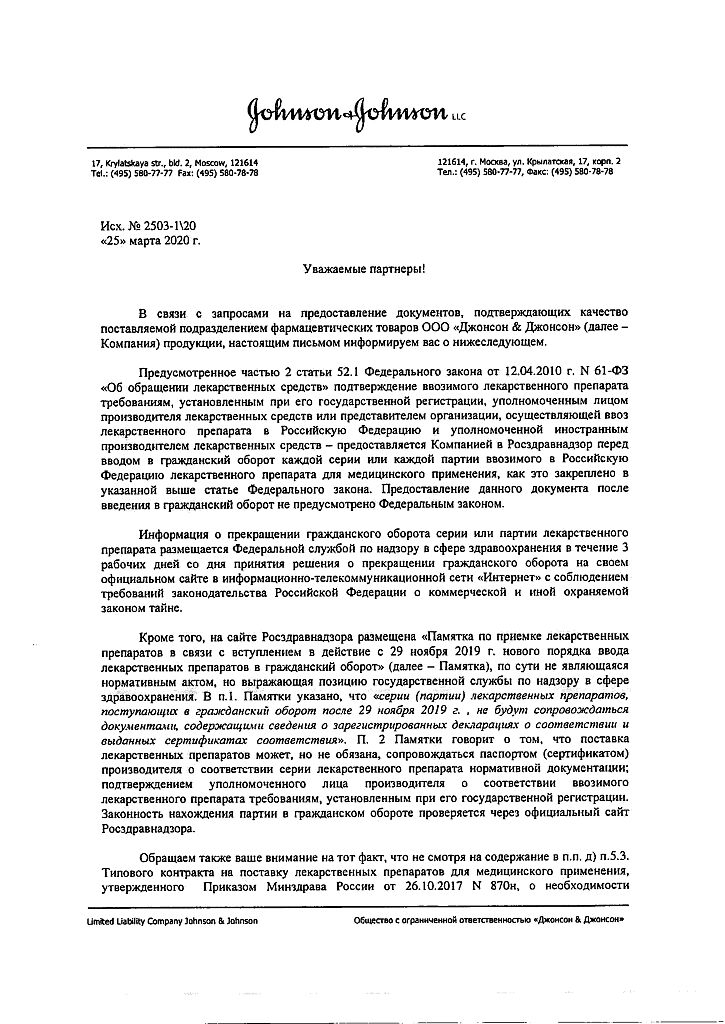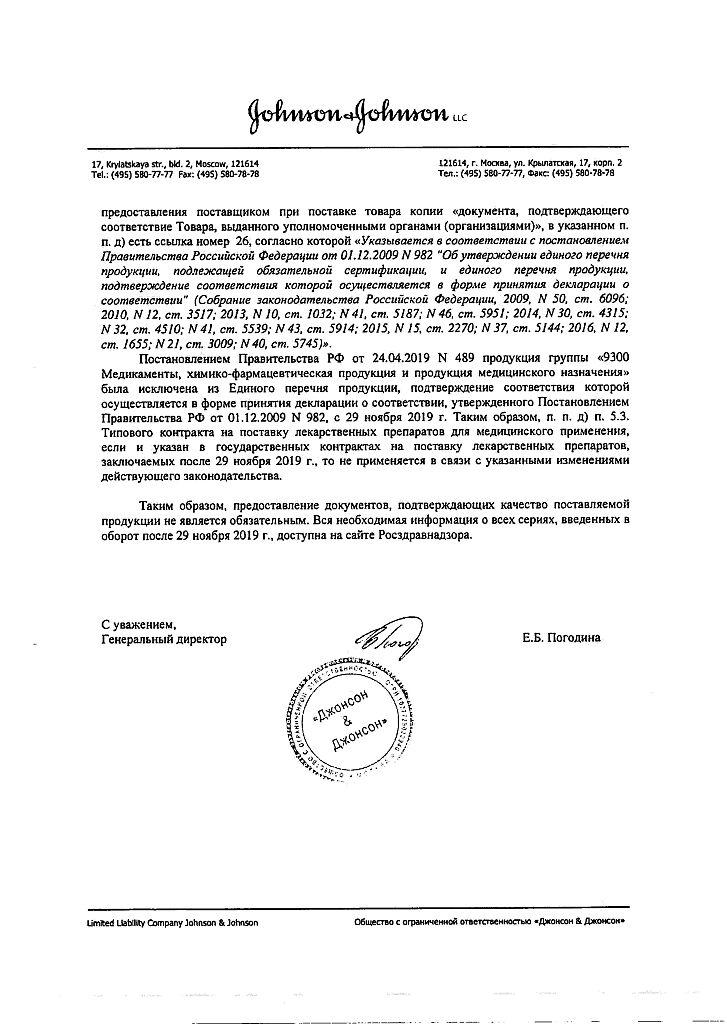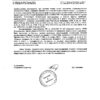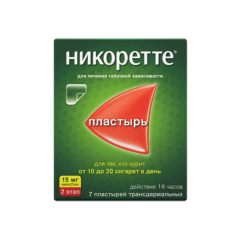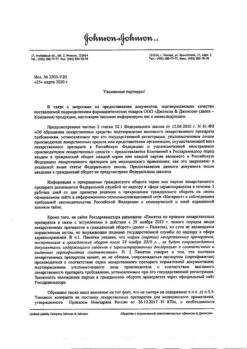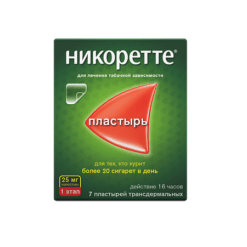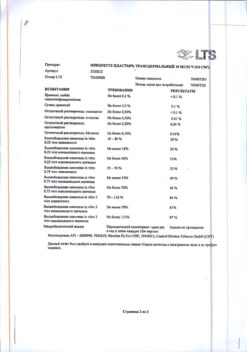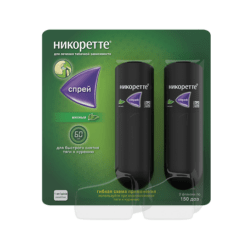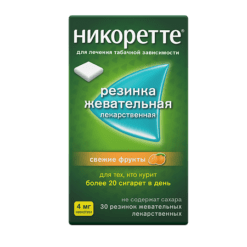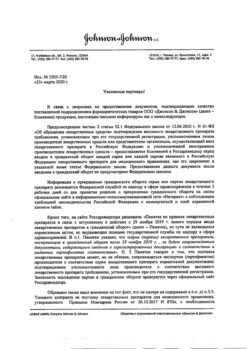No products in the cart.
Nicorette Fresh Fruit Chewing Gum, 2 mg 30pcs
€20.31 €16.92
Description
Pharmacodynamics:
After abrupt smoking cessation in patients who have used tobacco-containing products daily for a long time, withdrawal syndrome may develop, which includes: dysphoria, insomnia, increased irritability, anxiety, impaired concentration, reduced heart rate, increased appetite or weight gain. An important symptom of withdrawal syndrome is also a desire to smoke.
In the treatment of tobacco addiction nicotine replacement therapy reduces the number of cigarettes smoked, reduces the severity of withdrawal symptoms arising from complete cessation of smoking in those who decided to quit smoking; facilitates temporary abstinence from smoking and also helps to reduce the number of cigarettes smoked by those who can not or do not want to give up smoking completely.
Pharmacokinetics:
Nicotine from chewing gum is quickly absorbed through the mucous membrane of the cheek and detected in the blood in 5-7 minutes. The maximum concentration of nicotine is reached after 30 minutes after the beginning of chewing.
The distribution volume of nicotine during intravenous administration is about 2-3 liters/kg, and the half-life is about 2 hours. Nicotine is mainly excreted by the liver, its average plasma clearance is about 70 l/h. Nicotine is also metabolized in the kidneys and lungs. More than 20 nicotine metabolites have been identified that are inferior to it in activity.
The binding of nicotine to plasma proteins is less than 5%.
Primary metabolite of nicotine in plasma – cotinine – has a half-life of 15-20 hours, and its concentration is 10 times higher than that of nicotine.
Urinary excretion is primarily cotinine (15% of the dose) and trans-3-hydroxy-cotinine (45% of the dose). Between 10% and 30% of the dose of nicotine is excreted unchanged in the urine.
Progressive deterioration of renal function is accompanied by a decrease in total clearance of nicotine. Its pharmacokinetics does not change in cirrhotic patients with mild impairment of liver function (Child-Pugh index 5) and decreases in cirrhotic patients with moderate impairment of liver function (Child-Pugh index 7). Smokers treated with hemodialysis have increased plasma nicotine concentrations.
Elderly patients have a slight decrease in total nicotine clearance, which does not require dose adjustment.
Indications
Indications
Treatment of tobacco dependence by reducing the need for nicotine in the following cases:
• reduction of withdrawal symptoms that occur with complete cessation of smoking in patients who decide to quit smoking;
• with a temporary cessation of smoking;
• reducing the number of cigarettes smoked by those who cannot or do not want to completely quit smoking.
Pharmacological effect
Pharmacological effect
Pharmacodynamics:
After abrupt cessation of smoking, patients who have used tobacco-containing products daily for a long time may develop a withdrawal syndrome, which includes: dysphoria, insomnia, increased irritability, anxiety, impaired concentration, decreased heart rate, increased appetite or weight gain. An important symptom of withdrawal syndrome is also the desire to smoke.
In the treatment of tobacco addiction, nicotine replacement therapy reduces the need for the number of cigarettes smoked, reduces the severity of withdrawal symptoms that occur with complete cessation of smoking in those who decide to quit smoking; facilitates temporary abstinence from smoking, and also helps to reduce the number of cigarettes smoked for those who cannot or do not want to completely quit smoking.
Pharmacokinetics:
Nicotine coming from chewing gum is quickly absorbed through the mucous membrane of the cheek and is detected in the blood within 5-7 minutes. The maximum concentration of nicotine is reached 30 minutes after the start of chewing.
The volume of distribution of nicotine when administered intravenously is about 2-3 l/kg, and the half-life is about 2 hours. Nicotine is mainly eliminated by the liver, its average plasma clearance is about 70 l/h. Nicotine is also metabolized in the kidneys and lungs. More than 20 nicotine metabolites have been identified that are inferior to it in activity.
The binding of nicotine to plasma proteins is less than 5%. In this regard, disturbances in nicotine binding during concomitant use of other drugs or changes in plasma protein levels in various diseases should not have a significant effect on nicotine kinetics.
The primary metabolite of nicotine in plasma, cotinine, has a half-life of 15-20 hours, and its concentration is 10 times higher than that of nicotine.
Mainly cotinine (15% of the dose) and trans-3-hydroxy-cotinine (45% of the dose) are excreted in the urine. From 10% to 30% of the nicotine dose is excreted unchanged in the urine.
The progressive deterioration of renal function is accompanied by a decrease in the overall clearance of nicotine. Its pharmacokinetics does not change in patients with liver cirrhosis with mild liver dysfunction (Child-Pugh index 5) and decreases in patients with liver cirrhosis with moderate liver dysfunction (Child-Pugh index 7). Smokers treated with hemodialysis experienced increased plasma nicotine concentrations.
In elderly patients, there is a slight decrease in the total clearance of nicotine, which does not require dose adjustment.
Special instructions
Special instructions
Patients with diabetes may need to reduce their insulin doses after stopping smoking.
Doses of nicotine that are easily tolerated by adult and teenage smokers can cause severe toxicity in children, which can lead to death. It is important not to leave nicotine-containing products unattended, as this may lead to their misuse and ingestion by children.
Polycyclic aromatic hydrocarbons contained in tobacco smoke induce the metabolism of drugs metabolized by the CYP1A2 isoenzyme (and possibly CYP1A1). Quitting smoking can cause a slowdown in metabolism and, as a result, an increase in the concentration of these drugs in the blood. This has potential clinical implications for drugs with a narrow therapeutic index, such as theophylline, tacrine, clozapine and ropinirole.
Persons with impaired chewing function are recommended to use other dosage forms. People who wear dentures may have difficulty chewing Nicorette® gum. Chewing gum can stick to dentures and, in rare cases, cause damage.
If the medicine has become unusable or has expired, do not throw it into wastewater or onto the street! Place the medication in a bag and place it in the trash. These measures will help protect the environment!
Active ingredient
Active ingredient
Nicotine
Composition
Composition
1 medicinal chewing gum contains:
Active ingredient:
nicotine-polymer complex – 11 mg (the indicated amount is equivalent to 2.2 mg of nicotine, including 10% excess).
Excipients:
Chewing gum core: chewing gum (base)* – 560 mg, xylitol – 314 mg, peppermint oil – 30 mg, sodium carbonate – 20 mg, sodium bicarbonate – 10 mg, acesulfame potassium – 2 mg, levomenthol – 2 mg, magnesium oxide – 1 mg;
Chewing gum shell: xylitol – 294 mg, peppermint oil – 9 mg, gum arabic – 9 mg, titanium dioxide – 7 mg, carnauba wax – 1 mg.
* Chewing gum base is a mixture of various types of wax, resin and other hydrocarbons (about 60%) and calcium carbonate (up to 40%).
Pregnancy
Pregnancy
Smoking during pregnancy is associated with risks such as intrauterine growth restriction, premature birth, or stillbirth. Smoking cessation is the single most effective intervention for improving the health of both the pregnant woman and her baby.
Quitting smoking early is the best option.
Nicotine crosses the placenta and is excreted in human milk, and therefore its use may pose a danger to the fetus or child.
Patients should be informed of the need to attempt to quit smoking without nicotine replacement therapy. If such attempts are unsuccessful, the decision to carry out therapy is made after comparing the possible positive effect for the mother and potential harm to the fetus.
Nicotine passes into breast milk in small quantities even when taken in therapeutic doses, which can negatively affect the baby’s health when the drug is taken by a nursing mother. Therefore, you should refrain from using Nicorette® chewing gum during breastfeeding.
If you are unable to quit smoking, use of the drug should only be started after consultation with your doctor. In order to reduce the negative effects of nicotine on a child, Nicorette® chewing gum should be used immediately after feeding.
Contraindications
Contraindications
Hypersensitivity to nicotine or other components of chewing gum.
Side Effects
Side Effects
Some symptoms may be due to nicotine withdrawal due to smoking cessation.
These include: dysphoria or depressed mood, insomnia, irritability, dissatisfaction or anger, anxiety, difficulty concentrating, restlessness or impatience.
Other effects associated with smoking cessation may also occur: decreased heart rate, increased appetite or weight gain, dizziness or near-syncope, cough, constipation, bleeding gums or aphthous ulcers, nasopharyngitis.
Nicotine craving, considered a clinically significant symptom, is an important manifestation of nicotine withdrawal after smoking cessation.
Most adverse reactions were observed in the early phase of treatment and are predominantly dose-dependent in nature.
In the first few days of treatment, irritation of the mucous membrane of the oral cavity and pharynx may occur. Continuation of treatment leads to adaptation.
When using medicinal chewing gum Fresh mint, allergic reactions (including symptoms of anaphylaxis) rarely develop.
Interaction
Interaction
There are no clear clinically significant interactions between nicotine replacement therapy and other drugs. However, theoretically, nicotine may enhance the hemodynamic effects of adenosine, i.e. lead to an increase in blood pressure and heart rate, and also increase the response to pain (angina-type chest pain) provoked by the administration of adenosine.
Overdose
Overdose
Excessive nicotine intake from replacement therapy and/or smoking may cause overdose symptoms.
Symptoms of overdose are similar to those of acute nicotine poisoning and include nausea, salivation, abdominal pain, diarrhea, sweating, headache, dizziness, hearing loss and severe weakness. When using high doses of nicotine, hypotension, weak and irregular pulse, difficulty breathing, circulatory collapse and generalized seizures may occur.
Nicotine in doses tolerated by adult smokers can cause severe symptoms of intoxication, including death, in young children.
Treatment of overdose: nicotine use should be stopped immediately and symptomatic treatment should be prescribed. Activated carbon reduces the absorption of nicotine in the gastrointestinal tract. If necessary, artificial respiration and oxygen are prescribed.
Storage conditions
Storage conditions
Store at a temperature not exceeding 25 °C.
Keep out of the reach of children.
Shelf life
Shelf life
3 years
Manufacturer
Manufacturer
McNeil AB, Sweden
Additional information
| Shelf life | 3 years |
|---|---|
| Conditions of storage | Store at a temperature not exceeding 25 ° C. Keep out of reach of children. |
| Manufacturer | McNeil AB, Sweden |
| Medication form | chewing gum |
| Brand | McNeil AB |
Other forms…
Related products
Buy Nicorette Fresh Fruit Chewing Gum, 2 mg 30pcs with delivery to USA, UK, Europe and over 120 other countries.


